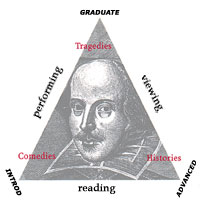| | Essay prompt | -
"Though difficult, I find reading Shakespeare the most rewarding method of engaging the plays. The text is Shakespeare’s contribution. But in the moment of reading, artistic authority is equally shared with Shakespeare." - At Swanton Ranch, "The Dream Team" stood in a forest to practice our play, hearing Puck recite, "A crew of patches, rude mechanicals, that work for bread upon Athenian stalls, were met togetherto rehearse a play." (Act III, Scene ii, MND) We were much the same.We even had some hard-hat "rude mechanicals" accidentally appear in thebackground as we spoke!

- Before we arrived, a place was sought out for us, our director no doubt having thoughts much like these: "Pat, pat; and here's a marvail's convenient place for our rehearsal. This green plot shall be our stage, this hawthorn brake ourtiring house." (Act III, Scene i, MND)
- This quarter I had the opportunity to perform Edgar in a small production of King Lear. I truly believe Edgar is the embodiment of Shakespeare. I just had to perform him to figure it out. Now, I must confess; I haven’t read every Shakespeare play twice, so I don’t know if other characters fit the mold better than Edgar. Also, I assure you I’m not losing my mind as I write this. I feel quite healthy. I just had one of those most rare visions. Fortunately, I didn’t have to be an ass to have this dream. On the Dover cliffs, under the hot sun, with a director screaming action, and a camera pointing towards me, I found Shakespeare.
- Art is the imaginative bridge that communicates a vision to an audience. Bottom is a visionary, but not an artist. He identifies Peter Quince, the only poet he knows, as the organ by which his vision can be conveyed to the world.
|



